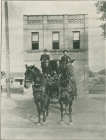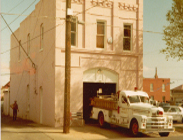History of the
HOSE Co. No. 3
Fire Museum
The two-story building is built of red brick with a large block, white sandstone front on the building and was designed by local architect J. (John) F. Bishop in the style of the day. Bishop would later be killed in the "Eden Train Wreck" just north of Pueblo, which was one of the worst railroad disasters of the time. The first floor consisted of two stalls for the horses, room for the hose cart, the bottom half of the hose drying tower, and a stairwell leading to the second floor. The second floor consisted of a sleeping room, sitting room with four lockers, a bath room consisting of a bath tub, water closet, and wash bowl, plus a feed room with open doors and block and tackle for pulling the hay to the second story. (Information courtesy of the Pueblo Masonic Temple Association.)
Hay door and block and tackle in the rear of the museum.
Hose Co. No. 3 soon after being constructed.
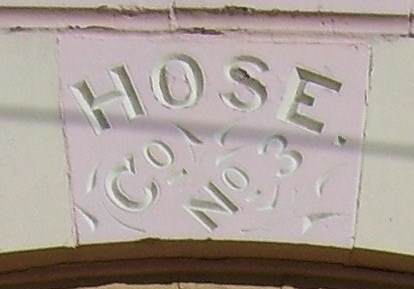
Chiseled into the building is "Hose Co No 3"
The horses were housed towards the alley side (left) of the building. They used to take them down to what is now Stauter Field on Abriendo Ave. in Pueblo to graze the horses. But when they were inside the building, they would stick their head through the window and lick the limestone bottom of the window housing. An old firefighter (Walt Pickerel) visiting the museum told the story about the horses. It was thought to be damaged from water erision by the city when they "fixed" the window in the early 1990's. Below is a picture of the window today.
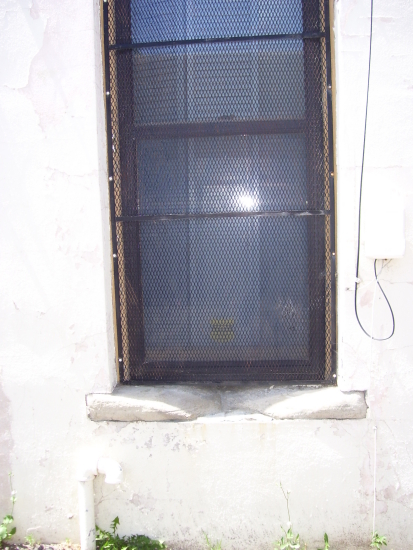
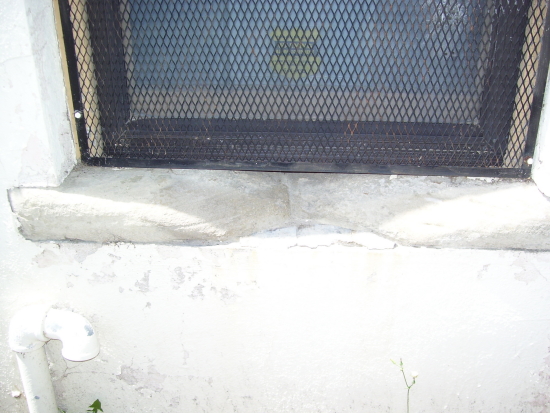
The hay loft was converted into a kitchen in 1915, when the department ended its horse drawn era. There are still the double doors into the kitchen that open to the back of the building, and the block and tackle are still in place at the museum. The original brass pole is still intact from the bedroom down. The rear door has since been sealed up, as it was built as a drive through station.
Fire Station 3 in the 1930's. Fire Station 3 in 1970.
The fire station served the City of Pueblo until March 9, 1979, at 7:00 a.m. when the current Fire Station 3 was opened two blocks away. The last call in the fire house came at 4:18 a.m of March 9th. For ten years the building was used for storage by the Pueblo Fire Department.
In the fall of 1989, George Gussenbauer (a local businessman and fire buff) opened a museum in the old Hose Co. No. 3 fire house. He mixed his personal collection with city owned property and ran the museum for several years. He made many improvements to the building, such as adding stained glass above the truck door (even though it lists the building as being established in 1881.)
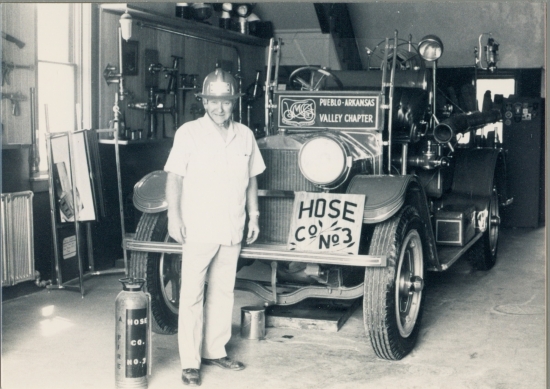
Pueblo businessman George Gussenbauer, founder of the Hose Co. No. 3 Fire Museum.
Since that time, the building has been designated a Pueblo Historical Landmark and is protected from demolition and major alterations. The restoration of the building has begun with a $10,000 grant from the Colorado Historical Society's State Historic Fund for a Building Assessment, which was completed in late 2008. Work is ongoing, slowly but surely. This will help preserve the heritage and artifacts of the Pueblo Firefighters and the Pueblo Fire Department.
The historic designation marker for the building.
In 2005, the Pueblo FireFighters Historical Society made an agreement with the city to take control of the artifacts and pictures in the building, to go along with the trucks and hose carts owned by the historical society (see Pueblo Firefighter Historical Society tab). Rick Mark, who oversaw the maintenance and restoration of the fire trucks at that time was the President of the historical society, with Gary Micheli being Vice-President of the historical society and Director of the fire museum.
In 1992, Gussenbauer took his collection and closed the museum. It remained as it was until 2002 when several firefighters started to inventory the contents of the museum. Fire Inspector Gary Micheli spearheaded the effort to preserve the artifacts and get them numbered and accounted for. He also started giving tours to small groups and individuals, and got other firefighters involved in the museum. One of these firefighters is Mark Pickerel, who is now the Curator of the museum, was one to jump on board in 2005. Pickerel had fond memories visiting his father (Walt Pickerel) when he was stationed at firehouse in the late 1960's.
The Hose Co. No. 3 - Fire Museum is housed in the old Station No. 3 of the Pueblo Fire Dept. in Pueblo, Colorado. The fire station was built in 1895 by the Masonic Temple (South Pueblo Lodge No. 31 A. F. & A. M. of Pueblo) and leased to the City of Pueblo for $75 a month. The Mason's had built a wooden hose house 5 years earlier on the same parcel of land, but tore it down to build the new station. The Masons leased the fire station to Pueblo until 1900, when the city purchased the building and land from the Masonic Temple for $500 and several stipulations. Two of these stipulations are that the city can only sell the property back to the Masons and no alcohol was to ever be on the premises.
